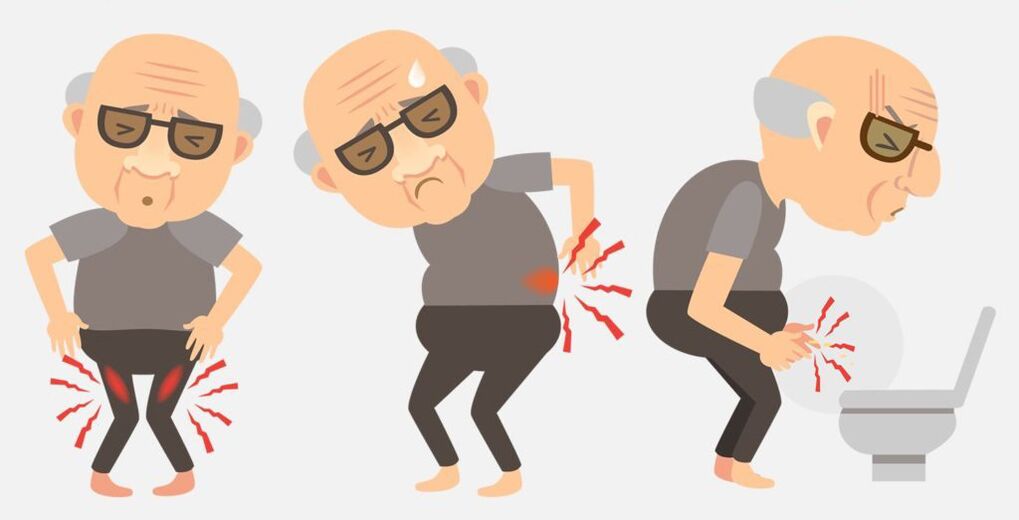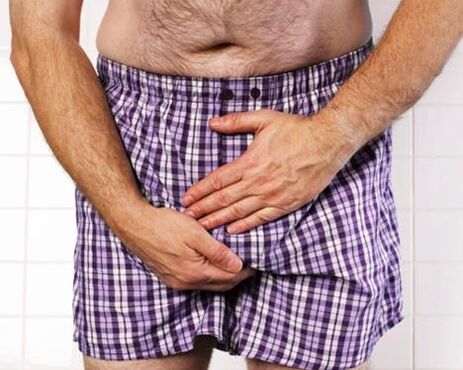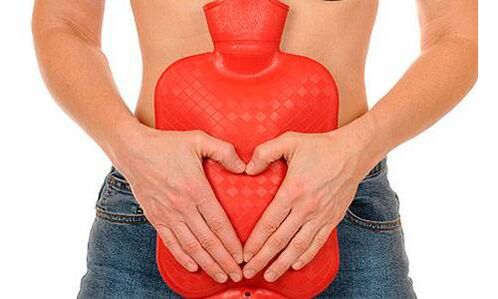The symptoms of prostatitis in men are not typical and specific, as it may seem at first glance. That is why in modern urology and andrology infertility is increasingly diagnosed in men of the most active reproductive layer - from 25 to 40 years. The prostate gland in men is an organ that performs several functions: barrier, regulating blood clotting, endocrine, reproductive, copulatory (sexual), the role of the bladder sphincter. The signs of prostatitis in men and its symptoms are multifaceted, especially in the chronic form - they cover all the functions of the organ and often make it difficult to diagnose.
Symptoms of acute prostatitis in men

What symptoms of prostatitis in men should make you pay attention to them and go to the doctor? Every man, especially at a young and sexually active age, should know about the signs of inflammation of the lower genital tract and the possible clinic of nascent prostate disease. Many young people postpone a visit to a urologist with the thought that this disease belongs to an older group.
Important.
Inflammation of the prostate is based on a complex of factors that begin to act at the age of 20-30 years.
- Sexually transmitted infections are the first thing that causes an active or slow process of inflammation. Chlamydia, mycoplasma infection, gonorrhea, trichomoniasis, gardnerellosis initiate urethritis, against which the development of inflammation of the gland is possible. Herpes simplex viruses, human papilloma, CMV, if they have not caused inflammation of the gland, significantly worsen the course of STIs and "pave the way" for bacteria in the tissue of the organ. Against the background of genital infections, opportunistic flora (staphylococci, Escherichia coli) often leads to prostate disease. Mixed flora is often found at diagnosis.
- Work accompanied by prolonged sitting is one of the factors provoking the disease. Such occupational risks or habits adversely affect prostate health.
- Arrhythmic sex - its rarity or accident, psychological problems that cause delayed or lack of ejaculation, erectile dysfunction, frequent masturbation - significantly disrupt the balance of arterial and venous blood flow in the gland.
- The effects of cold on the lumbar region, abdomen and limbs - winter sports and recreation, occupational risks associated with hypothermia, cause irreversible changes in the tissues of the gland.
Sexual infections, chronic hypothermia, venous blood stagnation and prostate secretion form the basis for the formation of chronic prostatitis. . . The symptoms of prostatitis of various forms are combined into three syndromes: painful, sexual and dysuric (urinary incontinence). The predominance of one of them is the reason for visiting a doctor - urologist, sexologist, therapist or surgeon. The vigilance and qualification of the doctor will determine the speed of the healing process.
Acute prostatitis, the symptoms of which are observed after or simultaneously with an active genital infection, is characterized by the following:
- Discomfort and pain when urinating.
- Cutting at the beginning or end of urination.
- Frequent and false desire to use the toilet.
- Pain around the anus, especially when sitting.
- Soreness during the act of defecation, a feeling of fullness in the rectum.
- Mucopurulent secretion from the urethra.
- Pain in the abdomen, radiating to the thigh, scrotum, back.
- Fever.
- Sexual dysfunction.
Each patient has a different degree of severity of symptoms. In addition, only a certain symptom may predominate. But often the acute process proceeds with scanty symptoms, which ensures frequent chronicity and an increase in the number of identified cases of chronic prostatitis.
The first signs of prostatitis
Symptoms of prostatitis appear in young men under the guise of acute respiratory infections or in the form of a classic genital infection. Depending on the type of pathogen, the signs of an acute process can be bright or erased.
The symptoms of prostatitis in men, initiated by gonococci, Staphylococcus aureus, Escherichia coli, as well as nosocomial infection (after urinary tract manipulations) are characterized by the following:
- The patient is suddenly affected by chills, which lasts from half an hour to two hours and ends with sweating.
- The temperature rises to 38-40 ° C.
- It is characterized by weakness, severe weakness.
The first symptoms of prostatitis in men may not be accompanied by the characteristic pain in the pelvis, rectum and groin. . . Also, sexual weakness is not typical. On the contrary, the catarrhal first stage of the disease is manifested by excessive excitability and premature ejaculation.
Important.
Urogenital chlamydia, which often causes chronic prostatitis, initially has only mild dysuric symptoms.
How does prostatitis in men, initiated by hematogenous or lymphogenic entry of flora into the prostate tissue? This type of disease, which accompanies common somatic infectious diseases (sinusitis, angina, pneumonia, abscesses, purulent skin diseases), may not be noticed by the patient. Against the background of the underlying disease, the temperature rises again and the symptoms of intoxication increase, mild dysuric phenomena and abdominal pain may develop.
Symptoms of chronic prostatitis in men

Bacterial or viral, congestive or infectious chronic prostatitis, whose symptoms are different, are united by the fact that inflammatory processes, although caused by different triggers, lead to three main manifestations:
- Pain syndrome.
- Disorders of urination.
- Sexual dysfunction.
Symptoms of prostatitis pain are also divided into three types:
- Extragenital - characterized by pain in the rectum, lower back, abdomen.
- Pelvic pain - the symptoms of pain do not appear as such, but there is a pronounced itching of the anus, tingling, paresthesia, neurosis, excessive sweating - this is due to the involvement of the pelvic nerve plexuses in the process.
- Genital - pain in the scrotum, lumbago in the testicles, groin and perineum.
- Mixed.
The symptoms of prostatitis pain form such a concept as "chronic pelvic pain syndrome in men".
Symptoms of inflammation of the chronic form of the prostate gland are accompanied by a violation and suppression of erection, ejaculation and decreased libido. Against this background, a neurosis-like syndrome is formed, which is of the sympathetic or parasympathetic type. The first is characterized by heart attacks, fever, subfebrile evening mood, sudden mood swings, inattention. For the second - drowsiness during the day, fatigue, insomnia at night, hypochondria, sweating, weight gain, lump in the throat, excessive salivation.
Among the dysuric phenomena, there is an increase in urination, difficulty in emptying the bladder, dripping and lethargy of the jet. Such signs have a marked resemblance to an adenoma, which sometimes complicates the diagnosis.
Important.
Chronic prostatitis in men after the age of 45 often occurs simultaneously with prostatic hyperplasia.
In the chronic form, spermatorrhea and prostatoria are observed - the secretion of prostate secretion from the urethra in combination with seminal fluid due to atony of the organ.
Asymptomatic prostatitis
Inflammation of the prostate is not always symptomatic. Often a man learns about a disease, for example, when performing an ultrasound diagnosis, when planning a child. They found calcifications in the tissues of the prostate, obliterated ducts, enlargement or reduction of the gland, sclerosis, impaired blood flow by Doppler sonography, varicose veins of the prostate plexus and pelvis.
Symptomatic prostatitis develops in young men after suffering from genital infections, in particular urogenital chlamydia and mycoplasmosis.Asymptomatic prostatitis is especially common after inadequate and incomplete treatment of these diseases. Examination of sperm often results in a decrease in the number of germ cells, a decrease in actively motile cells, agglutination and a decrease in lecithin grains. Periodic sexual failures are possible, to which the man does not pay attention.

Symptoms of exacerbation of prostatitis
Exacerbation of chronic prostatitis develops when exposed to adverse provoking factors - general somatic diseases, hypothermia, irregular sexual activity, alcohol abuse, exacerbation of infectious diseases of the genitourinary system, rectum.
The symptoms of exacerbation of prostatitis in men are similar to the onset of the disease. In the foreground are fever, malaise, fatigue, weakness, chills. Increased pain in the anus, a feeling of fullness in the rectum, lumbago in the groin, perineum. Sexual dysfunction and nervousness also worsen. When they go to the toilet, patients notice difficulty and increased urination, weakening of the jet, pain.
Characteristics of the course of some types of prostatitis
How does prostatitis manifest itself in men in its various forms? There are usually several types of the disease depending on the predominant process: infectious, bacterial, stagnant, purulent.
Infectious and bacterial prostatitis
The concept includes several nosological forms of the disease, or rather differentiates according to the types of pathogenic pathogens. Infectious prostatitis, whose symptoms can only be caused by pathogenic bacteria and viruses, can be initiated by sexually transmitted and opportunistic pathogenic flora. Conditionally pathogenic microorganisms, which usually inhabit the male urogenital tract, cause disease only in adverse factors. Escherichia coli, staphylococci, enterococci are most often found when semen and urine are inoculated. This is bacterial prostatitis.
Infectious prostatitis is registered predominantly among young people.This type of inflammation of the prostate gland most often causes chronicity and leads to infertility.
The clinical picture is characterized by the greatest brightness in gonorrhea, and in chlamydia, mycoplasmosis and opportunistic pathogens the symptoms are scarce, which often leads to chronic prostatitis.

Purulent prostatitis
The pyogenic flora is represented by gonococci, Pseudomonas aeruginosa, Escherichia coli, a methicillin-resistant strain of Staphylococcus. These microorganisms secrete a number of destructive enzymes, are aggressive to the tissues of the prostate and therefore initiate purulent fusion.Often purulent prostatitis ends with abscess, phlegmon, paraprostatitis, paraproctitis.
The purulent process is often initiated by bacteria that have entered the prostate gland in the following ways:
- From purulent foci in other organs.
- For medical interventions on the genitourinary system. The hospital flora is characterized by multiple resistance to antibiotics, which is why it leads to purulent prostatitis.
Purulent prostatitis, whose symptoms are most pronounced, often causes complications: urinary and bladder fistulas. And also such bacteria easily penetrate on the ascending path to the kidneys, pelvis and cups, causing their chronic inflammation.
Congestive prostatitis
The isolated course of this type of disease is practically excluded, because against the background of stagnant processes the microbial flora attaches and this type acquires an infectious form. Most often, urologists make such a diagnosis if no bacteria are isolated during the inoculation of the biomaterial. As a rule, the analysis performed after 2-3 weeks will already give a positive result for the bacterial flora.
Venous blood stagnation is often observed in varicose veins, pathology of the rectum, pelvic tumors, hypodynamics. Impaired outflow of prostate secretion, which is most often observed in sexual dysfunctions and irregular sexual activity, leads to stagnation and preconditions for inflammation.Stagnant prostatitis, whose symptoms coincide with infectious inflammation, are inextricably linked and follow one another.Symptoms will be complemented by varicose veins and rectal lesions.
It is obvious that in the chronic form of prostatitis the manifestations may be of a non-specific nature, which requires a thorough comprehensive diagnosis.
Important.
Any signs of genital infection in a man should be a reason to contact a urologist or venereologist for treatment.
Self-medication or neglect of the situation can serve as an impetus for the formation of a chronic form.
























